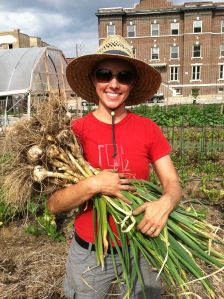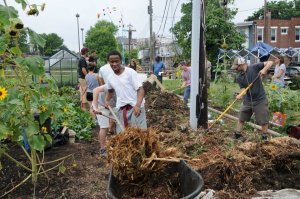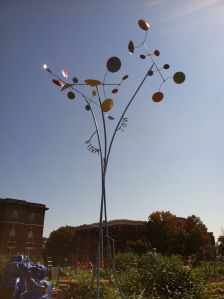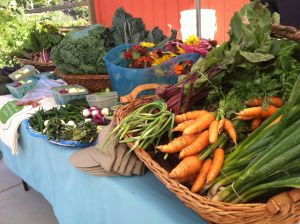Funding Opportunities Available for Community Greening Projects

Parks & People will be hosting grant workshops for three grants to fund community greening projects. The grants, which focus on community-led greening and service projects, would be a great opportunity for artists, community members, and organizations to receive funding to start or continue community projects.
Those interested in playground restoration and programs that support public parks can apply for the Partnership for Parks Grants. The grants provide awards ranging from $500-$5,000 and are co-sponsored through Baltimore City Department of Recreation & Parks and the Parks & People Foundation. Individuals and organizations interested in applying for the Partnerships for Parks Grants must attend a free workshop on either:
Tuesday, June 11, 2013 -or- Wednesday, May 29, 2013 6:00—8:00pm Rec & Parks Office, Druid Hill Park, 3001 East Dr., Baltimore 21217Community gardens, vacant lot restoration, and environmental education activities are just some of aims of the Neighborhood Greening & Clean Water Grants. The Clean Water Mini-Grant can provide up to $250 in funds for recipients, while the Neighborhood Greening Grant awards up to $1,000 in funds. Those interested in applying for either of the Neighborhood Green/Water grants must attend one of the following free workshops:
Wednesday, May 29, 2013 6:00—8:00 p.m. Parks & People Foundation, Stieff Silver Building, 800 Wyman Park Drive, Suite 010, Baltimore Tuesday, June 4, 2013 6:00—8:00 p.m. Zeta Center for Healthy & Active Aging, 4501 Reisterstown Road, Baltimore Wednesday, June 5, 2013 6:00—8:00 p.m. Bon Secours Community Works, 26 North Fulton Avenue, Baltimore Wednesday, June 12, 2013 6:00—8:00 p.m. HEBCAC, 1212 North Wolfe Street, BaltimoreIndividuals attending a workshop are asked to RSVP at least four days before the workshop they plan to attend. You can RSVP by contacting (410) 448-5663 x111 or valerie.shane@parksandpeople.
Two additional great resources for artists, community members, and organizations interested in greening spaces in Baltimore to check out are Baltimore Green Space and Power in Dirt. These resources can help provide an idea of what is available and some of what is already going on in Baltimore.
Community Greening Resource Network Summit

Have you ever walked past a community garden in the city and thought to yourself that you would like to be part of creating one? Or perhaps you’ve been riding by and saw a bright, green open space and appreciated the beauty it adds to any street? For anyone interested in becoming involved, already involved, or a seasoned eco-vet an event is being held this Thursday January 31st that is perfect for you! The CGRN Summit is an open summit in it’s 3rd year being held to discuss all things related to creating a green and sustainable Baltimore. It’s a great place to make your concerns heard and learn how to get (more) involved.
January 31, 2013 — 6:00pm – 8:30pm
Location: 2640 Space, 2640 St. Paul St., Baltimore, MD 21218
Please RSVP to community.greening@parksandpeople.org
Inspired by Weeds: A Profile of Artist/Farmer Elisa Lane
What’s your name?
Elisa Lane
How old are you?
32
Which neighborhood do you live in?
Describe your art.
When I lived in Philadelphia from 2001- 2009, I was choreographing and performing modern dance. During that time, I also performed as a theatre clown with Clowns Without Borders traveling internationally to make children laugh. When I moved to Baltimore, I worked at Wholly Terra in Hampden, welding and making stained glass sculptures. Traveling in Haiti with Clowns Without Borders, I became increasingly interested in sustainability and self-sufficiency, after being awestruck by the implications/connections between deforestation, lack of healthy drinking water, and poverty. I began pursuing sustainable agriculture in my quest for personal self-sufficiency and wanting to help others grow their own food.
What are you currently working on?
I’m the Farm Manager of Whitelock Community Farm, a resident-run urban farm in the Reservoir Hill neighborhood of
Baltimore. In 2010 we began building a neighborhood-supported agriculture project growing healthy, sustainable, and affordable produce for the residents in our neighborhood.
In addition to growing food for the community, the farm implements its mission through farm-based learning programs such as gardening and cooking classes for children and adults. We believe that everyone has a right to affordable, healthy, quality food accessed in a way that is environmentally sustainable and socially just.
We have a CSA and a market stand open on Saturdays where residents can buy fresh produce grown at the farm. Residents can also work at the farm in exchange for produce. In August of 2012, the Linden Market, a neighborhood corner store, will start carrying our produce as well.
What social justice cause(s) are you particularly drawn to, and why?
I was drawn to sustainable agriculture because the impact is not only environmental but also social, economic and healthful. I also just really love the company of other farmers!
Who or what inspires you?
Weeds! They are so prolific and will grow even in the poorest conditions. They are relentless and unapologetic.
What’s the best part about being an artist in Baltimore?
It seems like there’s a lot of possibility in Baltimore, because there’s so many neglected spaces just waiting for artistic, social projects. There is also a supportive community of likeminded artists and activists who are willing share their resources and ideas.
What’s the worst part about being an artist in Baltimore?
I can’t think of any.
What sort of and/or social justice projects would you love to take on?
I would love to create more events that cross-pollinate performance, food, and education. Like the STEW events, I love those! I also want the farm to be a launch pad for beginning gardeners, helping people in the city grow their own food.
Who would you like to collaborate on a project with?
I would love to collaborate with artists and educators on creating events around the celebration and education of healthy eating and growing food.
What’s one social justice organization that people need to know about, and why?
I just learned about City Slicker Farms in Oakland, CA. In addition to having a productive urban farm, they also have a backyard garden program. They help train new gardeners, test their soil for them, and hook them up with a garden mentor who works with them for a year. Then, in a year, the new gardener becomes the mentor, educating other backyard gardeners. Providing fresh produce to neighbors is one thing, but helping growing new gardeners that can produce their own food is where the real revolution is.
How do you think artists are changing Baltimore?
Artists are visionaries that help us see our world and the way we live in new ways. They help connect the intellectual with the emotional, which is a catalyst for change. At its best art moves us to take action.
~~~
Are you an artist working for social justice? Do you have something to say?
Leave a comment below if you’d like to fill out the Baltimore A + J artist profile questionnaire!
Digital Media as a Tool For Change: The Monteverde New Media Expedition

Recently, I found myself on a plane to Central America, heading for digital video boot camp. Yes, you read that correctly. Digital video boot camp! Couldn’t I have learned how to shoot a camera and use video editing software right here in Baltimore? Yes. Did I really have to travel all the way to Costa Rica to do this? No. But I did—for a variety of reasons both logical and random. And here is what was awesome about it: I learned to make a rough cut video documentary. While hiking. And traveling. And “interviewing” people in a language that I don’t know.
The brainchild of husband-wife video documentary team Austin Haeberle and Wendy Maria Jacques, the Monteverde New Media Expedition drew six participants from six far-flung locations (Los Angeles, Flagstaff, Queens, Oroville, London and Baltimore). We all came to learn video-making skills in a full-immersion format. We were also part of a media-based project seeking to protect and preserve an important ecosystem in Costa Rica. Each of our rough cuts will eventually get cleaned up, subtitled and embedded within a larger digital narrative that will live online and will be embedded with educational tools. The intent is to create an effective tool for education about the human, economic and biological assets of the region in order to make these stories more accessible and alive.
The endeavor brought us face to face with farmers, educators, advocates and others who are living and working within a 164,000-acre parallelogram of land stretching from the Gulf of Nicoya to the cloud forests of Monteverde. With lots to do and not much time to do it, our schedule ran something like this:
Days 1-4: Hike, travel, interview people, shoot a ton of footage
Day 5: Learn Final Cut Pro X and begin using it
Day 6: Self-produce a 3-minute rough cut documentary (one per participant); present said documentary at a community screening
Day 7: Fly home. No rest for the weary, as the saying goes.
We six participants made six mini-documentaries in as many days. I learned that:
- Video editing software is surprisingly addictive.
- If it can go wrong, it will. During my particular interview, which was conducted at the base of a huge old tree in the heart of the rainforest, we ran out of both memory and battery power. Oh, and it was raining.
- Hiking for hours with video equipment is tricky and laborious, but even a boom microphone can traverse two ridgelines, a wind break, a valley descent and a good amount of barbed wire.
- There is no way I could have, or would have learned all this in six days or less back home. Not because there aren’t good opportunities to learn and to create here in Baltimore- there are! But the faraway, full-immersion experience enabled me to get far enough outside of myself to try something altogether different and new.
Walking off an airplane and into someone else’s larger vision for regional storytelling and change was a tremendous, if sometimes challenging experience. In the end, it was both rewarding and informative. It gave me a glimpse into the role digital media can play in assisting a group of individuals to articulate a broadly-shared vision for a region, while each telling their own uniquely personal stories.
Can we do the same here at home in Baltimore? I sure hope so.
Read more about the Monteverde New Media Expedition and the Bellbird Biological Corridor.
Check out the rough cut here:





